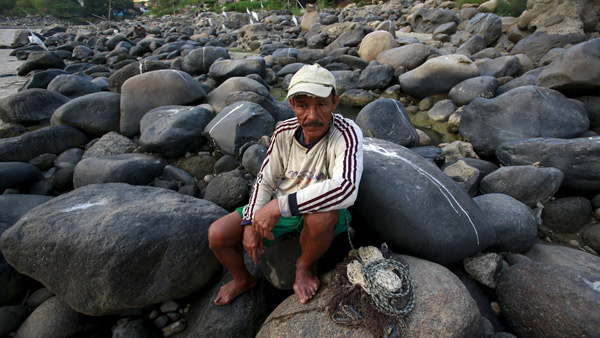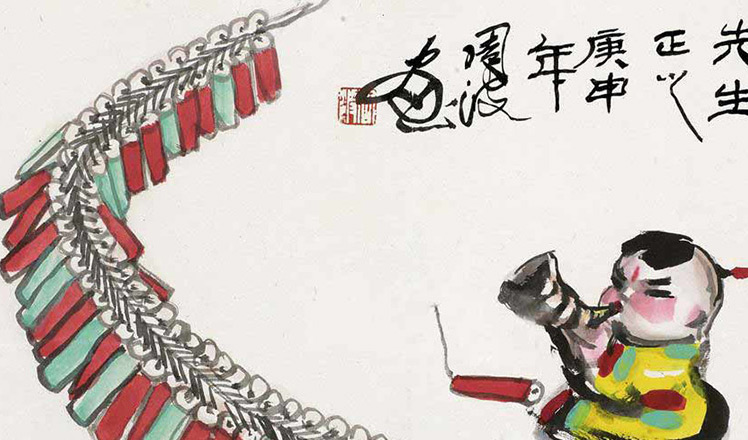El Nino expected to wreak havoc in S. America well into 2016
Updated: 2016-01-26 15:40
(Xinhua)
|
||||||||
 |
|
Fisherman Hector Alvarado sits on rocks that were once covered by the waters of the Magdalena river, the longest and most important river in Colombia, in the city of Honda, Colombia January 14, 2016. [Photo/Agencies] |
During the day, however, the mercury has swung to the opposite extreme, with a record-breaking high of 45 degrees Celsius registered for Dec. 29 in Puerto Salgar, Cundinamarca.
In the capital Bogota, one of the country's colder spots, mid-January temperatures rose to 23 degrees Celsius, 10 degrees warmer than average.
Farther south, in Bolivia, El Nino has brought hail, flash floods and drought, while sending the seasonal rains expected this time of the year over to neighboring Brazil.
According to government sources, since November El Nino has led to 14 deaths, left some 20,000 families homeless, destroyed 5,500 hectares of crops and caused damage in 78 of the country's 339 cities.
The phenomenon also threatens 1.4 million heads of cattle and other livestock across five departments.
"The problem is that now El Nino is threatening drought, which has begun to damage crops. We hope the weather reaches some kind of balance to avoid the greater loss of agricultural production," Rural Development and Land Minister Cesar Cocarico told Xinhua.
The World Meteorological Organization (WMO) expects this El Nino to be among the four strongest registered in the past 65 years.
For Bolivia, the government has prepared contingency plans to attend to some 100,000 families, but to date only 20,000 families have been directly affected by extreme weather, the Civil Defense agency said.
The ripple effects, however, may reach many more people.
Andean mountain communities in Ecuador, Peru and Bolivia are set to see more drought.
A lack of water is also affecting South America's electricity generation, due to insufficient water at hydropower plants, the main source of electric energy in Colombia, Brazil and Venezuela.
Lower energy production could in turn affect production and eat away at Latin America's gross domestic production (GDP) in 2016.
- A glimpse of Spring Rush: little migrant birds on the way home
- Policy puts focus on genuine artistic students
- Police unravel market where babies are bought, sold as commodities
- More older pregnant women expected
- Netizen backlash 'ugly' Spring Festival Gala mascot
- China builds Mongolian language corpus
- Special envoy to visit Laos and Vietnam
- El Nino expected to wreak havoc in S. America well into 2016
- Police officer rescues frightened sloth at corner of busy highway
- US Secretary of State visits Laos, aiming to boost ties
- 2 Chinese nationals killed, 1 injured in suspected bomb attack in Laos
- New York, Washington clean up after fatal blizzard

 Creation of China Daily's Tibetan-style font
Creation of China Daily's Tibetan-style font
 Drone makers see soaring growth but dark clouds circle industry
Drone makers see soaring growth but dark clouds circle industry China's Zhang reaches Australian Open quarterfinals
China's Zhang reaches Australian Open quarterfinals
 Spring Festival in the eyes of Chinese painters
Spring Festival in the eyes of Chinese painters
 Cold snap brings joy and beauty to south China
Cold snap brings joy and beauty to south China
 First trains of Spring Festival travel depart around China
First trains of Spring Festival travel depart around China
 Dough figurines of Monkey King welcome the New Year
Dough figurines of Monkey King welcome the New Year
 Ning Zetao, Liu Hong named China's athletes of the year
Ning Zetao, Liu Hong named China's athletes of the year
Most Viewed
Editor's Picks

|

|

|

|

|

|
Today's Top News
National Art Museum showing 400 puppets in new exhibition
Finest Chinese porcelains expected to fetch over $28 million
Monkey portraits by Chinese ink painting masters
Beijing's movie fans in for new experience
Obama to deliver final State of the Union speech
Shooting rampage at US social services agency leaves 14 dead
Chinese bargain hunters are changing the retail game
Chinese president arrives in Turkey for G20 summit
US Weekly

|

|







